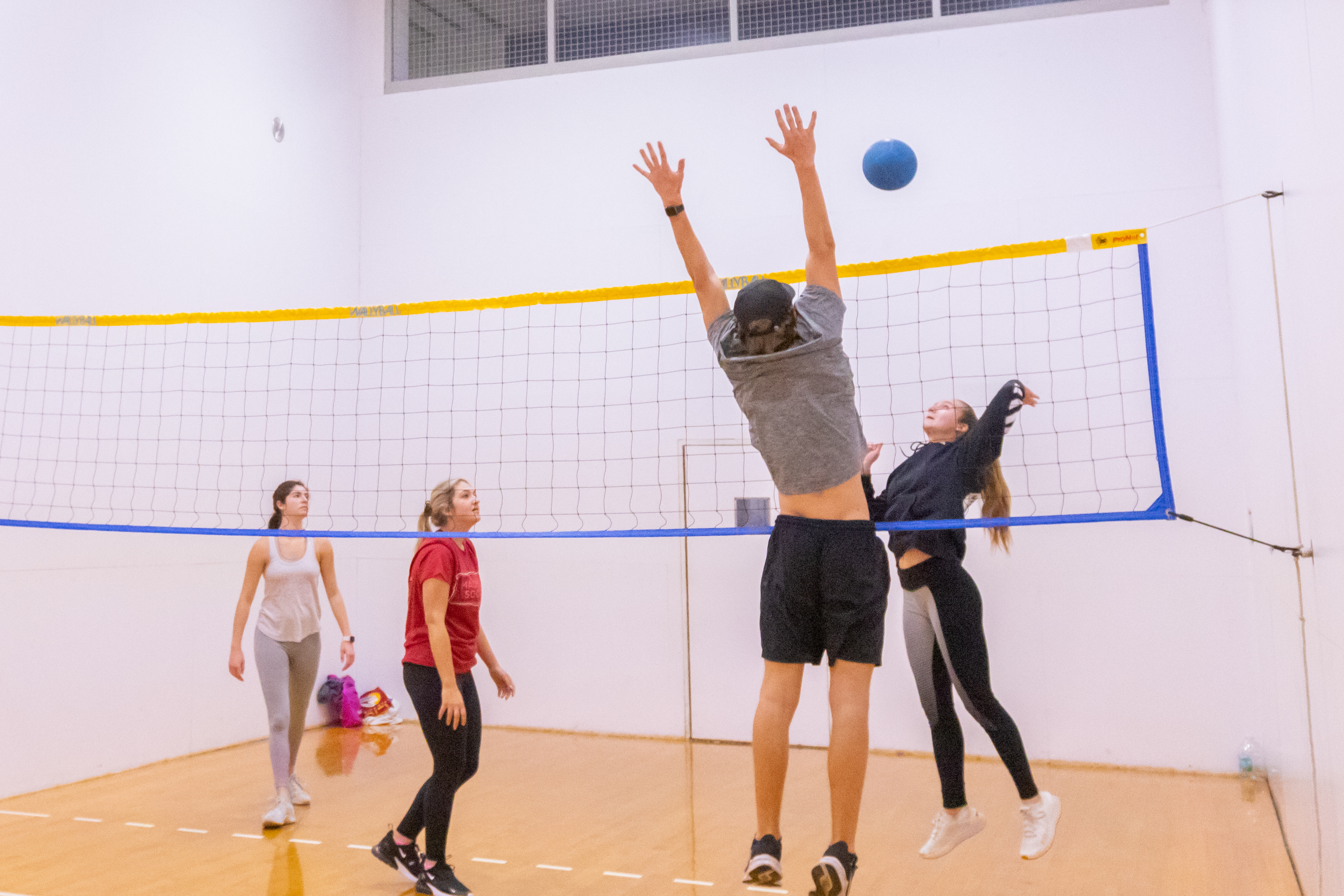Playing Rules
Updated August 14, 2024
General Rules
Florida State University does not provide accident insurance coverage for injuries received by Intramural Sports participants. Each participant should make sure that they have coverage either through family policies or the student insurance plan.
Florida State University PROHIBITS possession or consumption of alcoholic beverages on University property. Smoking and the use of smokeless tobacco is also prohibited at Campus Recreation facilities. This includes the Rec SportsPlex, Main Campus Fields, Westside Courts, and Tully Gym. Violators will be asked to leave the area. Failure to do so can result in forfeiture of the contest, suspension of individuals and/or teams, and appropriate action by the Office of Student Conduct & Community Standards and/or the FSU Police.
Sport Rules
I. GENERAL ELIGIBILITY
1. Participation is limited to currently-enrolled, fee-paying FSU students, faculty members, and full-time staff. FAMU & TCC students and members of the community are not eligible.
2. In order to participate in an intramural contest, each player must present their current, valid FSUCard. Check-in takes place at designated sign-in locations at the facility, not at the fields or courtside.
3. Additional information regarding player eligibility, team rosters, and participant check-in is available in the Seven Principles of Intramural Sports, available online at the FSU Intramural Sports web site and in the Intramural Sports Office at the Main Campus Fields (1001 W. St. Augustine Street). Requests for exceptions to any policy must be directed to the IM administrative staff during regular weekday business hours in the Intramural Sports Office. No exceptions are granted at the fields or courts.
4. Participants must be able to access the Leach Center. A valid FSUCard is required to enter the facility. Faculty and staff must have a Leach membership or purchase a guest pass in order to participate.
II. TEAM COMPOSITION
1. Open league teams consist of 3 players, male or female in any combination. An open league team must have 3 players to start a match. Co-ed league teams consist of 4 players, 2 males and 2 females. A co-ed league must have at least 3 players to start (at least 1 of each gender) a match. Players who arrive late may be added to the roster and may enter the game at a dead-ball situation.
2 . A team’s roster may include an unlimited number of players. A team is not required to have a specific number of males or females on its roster (can be an all-male or all-female team), unless in the co-ed league. Team rosters will be formed based on the players who compete in the team’s first regular season game (sign-in at the courts on the night of the game). Additions may be made to the roster at any time throughout the season and during the playoffs until 12pm noon on the day of the championship game. New players will become part of a team’s roster when they sign-in at a subsequent game. No player may participate in more than one single gender or co-ed team. However, it is acceptable to play on one co-ed team and one single gendered team.
3. Substitutions may only take place between games.
4. If a player becomes injured and cannot continue playing immediately, they must leave the court. If a team desires to have that player remain in the game, and if the player cannot continue immediately, that team must use a charged time-out. If an injured player must leave the court, an in-game substitute for the injured player will be permitted. However, the injured player may not return for the remainder of the match. If a substitute is not available or not made for an injured player, that injured player may return to the match when ready to participate.
III. EQUIPMENT
1. All players must follow Leach Center guidelines in order to participate.
2. All players must wear court shoes. Players will not be permitted to wear turf, black marring sole, or any type of shoe that creates marks on the court surface. Shoes must be worn by all players. Sandals, flip-flops, and boots are not permitted.
3. Select jewelry is allowed to be worn during intramural competition.
Below is a list of jewelry that is not allowed:
• Hard plastic / metal jewelry including rings, watches, bracelets, etc.
• Jewelry with loose hanging loops / hoops
• Non-stud piercings
If a finger could fit through the space of a loose piece of jewelry, then it must be taken off. Sport specific Jewelry Policies may still apply. There is absolutely no jewelry allowed beneath the elbow in the following sports:
• Flag football (7v7 & 4v4)
• Basketball (3v3 & 5v5)
• Volleyball (Indoor & Sand)
If necklaces are worn, they must be tucked in and always remain tucked in. Individuals wearing religious or medical alert jewelry will be allowed to participate while wearing jewelry containing necessary information. In such cases, the jewelry should be taped to the skin with the medical information visible. The Intramural Sports Staff and Supervisors have the final say on approved jewelry for each sport.
IV. PLAYING AREA
1. The playing area is a standard racquetball court including all walls and the ceiling.
V. MATCH TIME & LENGTH
1. Match time is forfeit time. A team needs at least 3 legal players to begin the match. Any team that forfeits a match will not be eligible for the playoffs. If the forfeiting team wishes to play the rest of its regular season matches, the team captain must come into the Intramural Sports Office by noon on the next working day to present their case.
2. All matches will be best 2 of 3 games.
3. All games will use the standard scoring system with a point awarded only when the serving team scores.
A. In the first and second games, the game will be won when one team has scored 15 points and has at least a 2-point advantage over the opponent. No game shall exceed 17 points. If the teams are tied at 16-16, the next point scored will determine the winner.
B. The third and final game will be won when one team has scored 15 points and has at least a 2-point advantage over the opponent. There will be no cap on points in the third game.
4. The choice of serve or playing area shall be decided by mutual agreement of the team captains. If agreement cannot be made, a coin toss by the match supervisor between the designated captains of each team shall occur before the first game. If more than one game is played, the team not serving first in the previous game of the match shall serve first in the next game. A coin is tossed again if a third and deciding game is needed.
5. One (1) time-out will be allowed per team per game. The time-out shall be 60 seconds in length.
VI. METHOD OF PLAY
Serving
1. The service area is three (3) feet from the back wall.
2. The player in the right back position shall put the ball in play by hitting it with one hand only in an attempt to send the ball over the net and into the opponent’s court.
3. The serve may contact one (1) side wall on either side of the court. A serve that contacts more than one (1) side wall or the back wall before contacting the ground or an opponent shall be considered illegal and a side-out shall be awarded. Serves that hit the net are considered in play.
4. Hitting two (2) or more walls consecutively on the serve shall be considered out of bounds / illegal.
5. At the moment of service it is illegal for players of the serving team to wave their arms, jump, or form groups of two or more players for the purpose of forming a screen to conceal the action of the server.
6. The serve may not be blocked or attacked by the receiving team.
Contacting the Ball
1. Three contacts, not including an unsuccessful block, shall be permitted during each team’s volley.
2. A player may not reach over the net to attack the ball. A player may reach over the net during the follow through after a spike, or during a block on a team’s attack or third team hit.
3. A ball may not be held, lifted, pushed, thrown, or carried at any time. Using an open hand to contact the ball in an underhand motion or to direct the ball forward from behind the head with an open hand usually constitutes a lift or carry.
4. Any contact with the ball below the waist of a player (intentional or unintentional) is illegal and a point/side-out will be awarded.
5. Climbing the wall to block a set or serve is illegal.
6. If two opposing players contact the ball simultaneously above the net, either may play the ball on the next hit for the first of their team’s three hits.
7. If two teammates contact the ball simultaneously, this is considered one contact, and either of the players may make the next play on the ball. (This does not include action on block attempts.)
8. The net may not be touched by a player while the ball is alive. If the ball is driven into the net with such force as to cause the net to contact an opponent, such contact shall not be considered a fault.
9. Contact with any other part of a player’s body with the opponent’s side of the court during play constitutes a fault.
In Bounds / Out of Bounds
1. The ball shall be out of bounds whenever it contacts the ceiling or the back wall on the opponent’s side.
2. The side walls are in play at all times. The ball may be played off a single side wall in any play.
3. When a team is volleying the ball on their side of the court:
A. The team may deflect the ball off of the back wall on their side of the court only. The ball does not need to touch another player before crossing over the net into the opponent’s court. Such a play is considered legal and the ball will be live and in play.
B. The team may deflect the ball off of the ceiling on their side of the court only. In this case, another player must make contact with the ball before it passes over the net into the opponent’s court. If the ball crosses the net after contacting the ceiling without making contact with a player, a side-out or point will be awarded.
C. The team may deflect the ball off of two (2) or more walls and/or the ceiling on their side of the court only. In these cases, another player must make contact with the ball before it passes over the net into the opponent’s court. If the ball crosses the net after contacting two (2) or more walls and/or the ceiling without making contact with a player, a side-out or point will be awarded.
4. A ball that passes through the opening between the net and the wall on the first or second contact shall be considered dead and the point will be replayed. A ball that passes through this opening following the team’s third contact shall be considered dead and out-of-bounds with a side-out or point awarded.
Rotation
1. The team which receives the ball for service after a sideout shall rotate clockwise before serving. This includes a team’s first service in a game after their opponent’s first serve.
2. Backrow restrictions apply only to the player in the server position of the rotation. Such restrictions apply to both the offense (actual server) and defense (player who most recently served). These players may not spike or block a ball or attempt to spike or block a ball. A backrow violation results in a side-out / point.
VII. SPORTING BEHAVIOR
1. The mission of Intramural Sports is to provide a recreational environment for the University community which is safe and enjoyable. While the game atmosphere is often competitive, ensuring participant safety, providing a fun, social atmosphere, and promoting sporting behavior among participants, spectators, and team followers are our primary concerns. The game atmosphere should remain good-natured at all times. Participants shall maintain good sporting behavior throughout their participation in all facets of the intramural program.
2. The Sporting Behavior Rating System is intended to be an objective scale by which teams’ attitude and behavior can be assessed throughout the intramural sports league and playoff seasons. Behavior before, during, and after an intramural sports contest is included in the rating. The team captain is responsible for educating and informing all players and spectators affiliated with their team about the system.
3. A team is responsible for the actions of the individual team members and spectators related to it. Additionally, FSU Intramural Sports does not recognize the use of coaches. Only the team captain shall speak to the officials regarding administrative matters (protests, ejections, disqualifications, etc). Furthermore, the team captain’s efforts in assisting officials/staff to calm difficult situations and to restrain troubled teammates are key to controlling team conduct.
4. Sporting behavior is vital to the conduct of every Intramural contest. In order to encourage proper conduct during games, officials, administrative personnel, and supervisors shall make decisions on whether to warn, penalize or eject players or teams for poor behavior. These decisions are final. The Intramural Sports administrative staff will rule on further penalties as a result of unsporting conduct.
5. Each participant should choose their team members carefully, as all team members will suffer the consequences of any disciplinary action taken by the Intramural Sports staff against that team for violation of the intramural rules and sporting behavior guidelines. Protests or appeals of sporting behavior ratings will not be recognized. The Intramural Sports administrative staff reserves the right to review any rating given to a team.
6. Additional information regarding team and participant sporting behavior including the rating method, factors, and scale is available in the Sporting Behavior Principle of the Seven Principles of Intramural Sports, available online at the FSU Campus Recreation web site.






